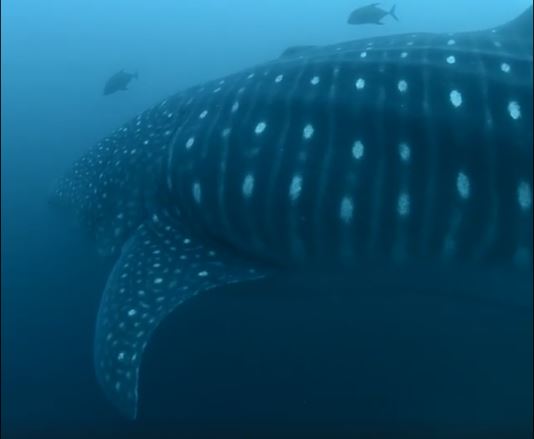I recently saw some film footage on an episode of David Attenborough’s “Blue Planet II” showing several silky sharks, Carcharhinus falciformis, seemingly scraping parasites off of a whale shark, Rhincodon typus. It occurred to me that this was a form of fish cleaning to add to my growing list.
I found confirmation of what I had seen on “Blue Planet II” on Facebook at https://www.facebook.com/galapagoswhaleshark/videos/1703426886362767/ : –
“Galapagos Whale Shark Project
Footage from a fin camera attached by our team and featured in BBC’s new Blue Planet 2:
We believe the silkies were rubbing/slapping against the whale shark in order to scrape off parasites. It does not seem to bother the Whale Shark at all.”
A whale shark, Rhincodon typus
Whilst researching the topic, I found the following details on Wikipedia: –
“Silky sharks (Carcharhinus falciformis) are themselves accompanied by juvenile pilot fish (Naucrates ductor), which “ride” the pressure wave ahead of the shark, as well as by jacks (Carangidae), which snatch scraps of food and rub against the shark’s skin to scrape off parasites”.
So, there we have an example of silky sharks removing parasites from whale sharks and jacks removing parasites from silky sharks.
I didn’t even know just what a silky shark was. According to Wikipedia, they are “also known by numerous names such as blackspot shark, grey whaler shark, olive shark, ridgeback shark, sickle shark, sickle-shaped shark and sickle silk shark”. They are “a species of requiem shark, in the family Carcharhinidae, named for the smooth texture of its skin. It is one of the most abundant sharks in the pelagic zone, and can be found around the world in tropical waters. Highly mobile and migratory, this shark is most often found over the edge of the continental shelf down to 50 m (164 ft). The silky shark has a slender, streamlined body and typically grows to a length of 2.5 m (8 ft 2 in). It can be distinguished from other large requiem sharks by its relatively small first dorsal fin with a curving rear margin, its tiny second dorsal fin with a long free rear tip, and its long, sickle-shaped pectoral fins. It is a deep, metallic bronze-gray above and white below.”
An image of a silky shark can be found at https://pin.it/if6poqdpzvpbka . A whale shark image can be found at https://pin.it/pmhgebz7gzmemv .


